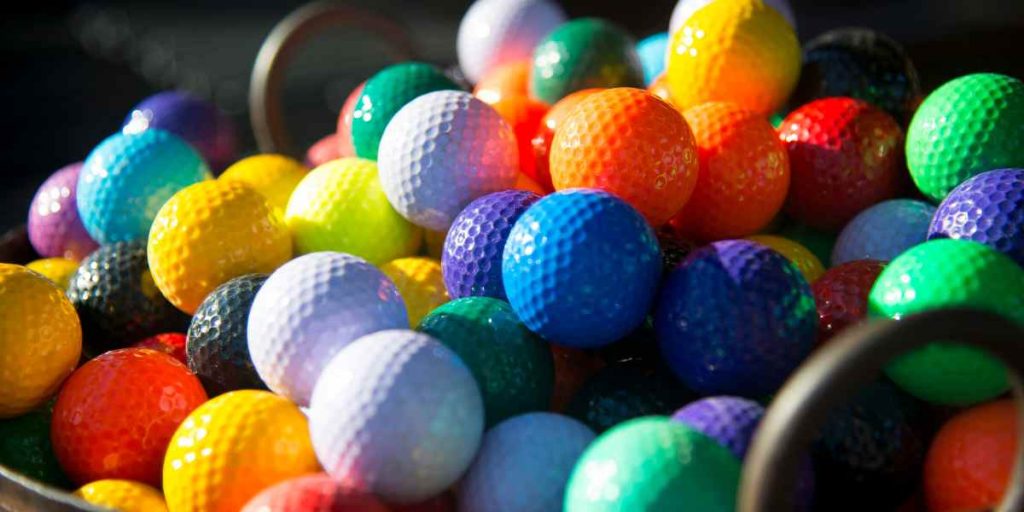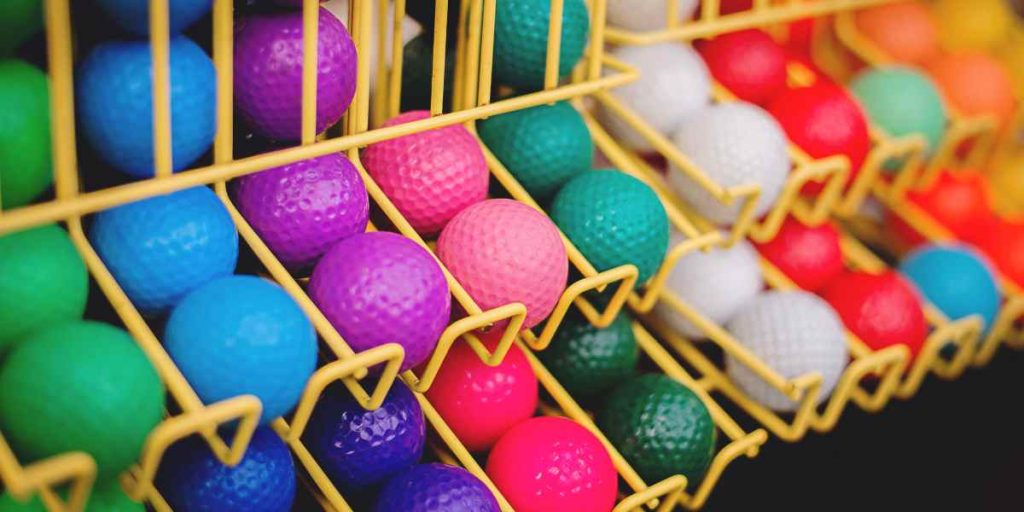Exploring Golf Ball Prices: How Much Does a Golf Ball Cost
Golf is a beloved sport for millions of people around the world, but it can be an expensive one. Whether you are a pro or a beginner, the question of how much does a golf ball costs is always an important one. In this post, we’ll take a look at the average cost of golf balls and what you should expect to pay depending on the quality and brand.
Table of Contents
Price ranges
Golf balls come in a wide range of prices, from bargain-basement models to high-end tour-level balls. The factors that affect the cost of golf balls vary depending on the manufacturer and technology used in the construction of the ball.
At the lowest end of the market, you can expect to find two-piece golf balls with a basic rubber core, plastic cover, and dimple pattern. These balls are designed for recreational golfers and can cost as little as $10 for a dozen balls.
Next up are three-piece balls, which typically feature a harder rubber core, a softer cover, and a more advanced dimple pattern. These mid-range balls are designed for the occasional golfer and can cost anywhere from $15 to $30 for a dozen.
At the top end of the market are tour-level balls, which are designed for the serious golfer. These balls feature a multi-layer construction with a highly resilient rubber core, a soft and durable cover, and a sophisticated dimple pattern. Tour-level balls can cost anywhere from $30 to $50 for a dozen.
The cost of golf balls also varies depending on the brand. For example, balls from Titleist, Callaway, and TaylorMade are typically more expensive than balls from brands such as Wilson, Top-Flite, and Srixon.
Finally, the cost of golf balls can also vary depending on the type of ball. Distance balls, for example, are designed to fly farther and are usually more expensive than tour-level balls. Similarly, golf balls with special features such as increased spin or durability can also cost more than standard balls.
Budget golf balls

Lower-priced golf balls are great for golfers who are new to the game, or for those who are looking to save money. Examples of lower-priced golf balls include Wilson Staff Duo Soft, Callaway Warbird, and TaylorMade Rocketballz.
The Wilson Staff Duo Soft has a two-piece construction, with a soft and durable cover and a low-compression core. This ball provides a soft feel and great spin control, making it a great ball for beginners.
The Callaway Warbird is a two-piece ball, with a soft cover and a low-compression core. It is designed to provide golfers with maximum distance and good spin control.
The TaylorMade Rocketballz is a three-piece ball, with a soft cover and a low-compression core. This ball is designed to provide maximum distance and great spin control.
Pros of Using Budget Golf Balls:
1. Lower Price: Perhaps the biggest advantage of budget golf balls is their lower price. For those who are just getting into golf or those who are looking to save money, budget golf balls can provide great performance at a fraction of the cost of premium golf balls.
2. Durability: Budget golf balls are often more durable than their more expensive counterparts. This is because they are made from cheaper materials and are designed to be tough and long-lasting.
3. Playability: Budget golf balls offer great playability for those who are just starting out or for those who are looking to save money. They are designed to provide good spin control, distance, and feel.
Cons of Using Budget Golf Balls:
1. Lack of Performance: Budget golf balls are not as high performing as their more expensive counterparts. They may not provide the same distance, spin control, and feel as premium balls.
2. Low Quality: Budget golf balls can be made from low-quality materials, which can affect their playability and lifespan.
3. Lack of Consistency: Budget golf balls may not provide the same level of consistency as premium balls. This means that they may not perform the same way each time they are hit.
Premium golf balls

Premium golf balls are the top-of-the-line and usually the most expensive balls on the market. The main benefit of premium golf balls is that they are designed to provide the highest levels of spin, control, distance, and feel. They are also typically made from higher quality materials and have a larger core, which helps them to generate more spin and distance.
Examples of high-priced golf balls include the Titleist Pro V1, TaylorMade TP5, and Callaway Chrome Soft. All three of these balls offer exceptional performance, but they come at a price. The Pro V1 is the most expensive of the three with a retail price of around $50 a dozen. The TaylorMade TP5 is slightly less expensive at around $40 a dozen, while the Callaway Chrome Soft is the least expensive at around $30 a dozen.
Pros of using premium golf balls include increased spin and control, increased distance, and a higher level of feel. The increased spin and control that comes with using a premium ball can help improve your accuracy and consistency. The increased distance can help you hit the ball farther and improve your scores. Finally, the increased feel of the ball can help you to better understand the shot you are making and help you become more consistent.
Cons of using premium golf balls include the higher cost and the fact that they can be harder to find. While the performance of premium golf balls is usually much better than other golf balls, the price tag can be a bit prohibitive for some. Additionally, these balls can be harder to find in some golf courses or stores, so you might have to go out of your way to find them.
Value packs

The cost-effectiveness of buying golf balls in bulk or in value packs is an important consideration for golfers of all levels. Buying golf balls in bulk or in value packs can help save money and provide a greater quantity of balls for practice and play. When purchasing golf balls, it is important to consider the pros and cons of both bulk and value packs.
Pros of purchasing golf balls in bulk include a lower cost per ball, more balls for practice and play, and no need to purchase multiple packages of balls. Buying in bulk is also more convenient since it often can be done online or in-store. Additionally, with bulk orders, there is typically more variety of ball sizes and types, which allows for greater customization.
The pros of purchasing golf balls in value packs include lower overall cost, multiple balls in one package, and some packs that come with additional items like tees or gloves. Value packs also provide convenience, since they can be purchased in-store or online.
The cons of purchasing golf balls in bulk include the need to store a large number of balls, the risk of receiving damaged, used, or counterfeit balls, and the possibility of purchasing a particular size or type that may not be suitable for the golfer. Additionally, if the golfer has a specific preference in terms of size or type, they may not be able to find the desired ball in bulk.
The cons of purchasing golf balls in value packs include the inability to customize the type and size of balls, the risk of receiving damaged, used, or counterfeit balls, and the possibility of buying balls that are not of the same quality or type. Additionally, the cost per ball may be higher than buying in bulk.
In conclusion, buying golf balls in bulk or in value packs can be a cost-effective way to purchase golf balls. However, it is important to consider the pros and cons of each option before making a purchase. Additionally, researching the quality and type of balls is important to ensure that the golfer receives the desired ball.
Shopping Tips: How Much Does a Golf Ball Cost

1. Shop Online: Shopping online is a great way to find golf balls on a budget. Many online retailers offer discounts and free shipping, especially for bulk orders. Look for online stores that specialize in golf balls and compare prices.
2. Check Out Discount Stores: Discount stores such as Walmart, Kmart, and Target often carry golf balls at discounted prices. Check these stores for sales and special offers.
3. Buy Used Balls: If you’re looking to save money, consider buying used golf balls. While these won’t be as good as new balls, they can be a great option for those on a budget. Look for used balls at sporting goods stores and online auction sites.
4. Buy in Bulk: If you’re an avid golfer, consider buying golf balls in bulk. This can save you money in the long run, as many retailers offer discounts on bulk purchases.
5. Take Advantage of Promotions: Many retailers offer special promotions, such as buy one get one free deal. Look out for these when shopping for golf balls.
6. Sign Up for Loyalty Programs: Many retailers offer loyalty programs that reward customers with discounts and free items. Signing up for these programs can help you save money on golf balls.
7. Ask for Discounts: Don’t be afraid to ask for discounts when shopping for golf balls. Many retailers are willing to negotiate prices, especially for bulk orders.
8. Shop During Sales: Look for sales during holidays or special occasions, such as Father’s Day or Christmas. This is when retailers offer the best deals on golf balls.
9. Look for Coupons: Look for coupons or special offers in newspapers and magazines. These can help you save money on golf balls.
10. Follow Online Stores on Social Media: Many online stores use social media to advertise sales and promotions. Follow your favorite online stores to stay up to date with the latest deals.
Common misconceptions about the cost of golf balls
Common misconceptions about the cost of golf balls lead many golfers to believe that the most expensive golf balls are the best choice for all golfers. However, this is not necessarily the case. Budget golf balls can still perform well for certain golfers, depending on their individual needs and preferences.
For example, golfers who play primarily on driving ranges or practice facilities may not need a golf ball with the same features and performance as a professional golfer. In these cases, a budget golf ball may be a better option. Budget golf balls are usually made with fewer layers, which can reduce spin and distance, but may be more durable than more expensive golf balls.
Golfers who play on courses with shorter holes may benefit from budget golf balls as well. These golfers may not need the extra spin and distance that higher-priced golf balls provide, and the lower price of budget golf balls may make them a better option.
In addition, budget golf balls may be a better choice for golfers who are still learning the sport. Beginner golfers may not need the added features of a higher-priced golf ball and may be better served by a budget golf ball.
Overall, budget golf balls can be a great option
Read here what age to start golf lessons…..
Conclusion
The cost of a golf ball can vary greatly depending on the type, brand, quality, and quantity purchased. Generally, a single golf ball can cost anywhere from $1-$50. Higher quality balls, such as those used by professional golfers, can cost much more. When buying in bulk, prices can be significantly lower.
